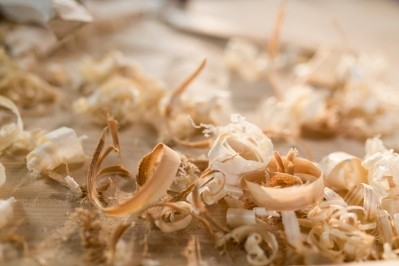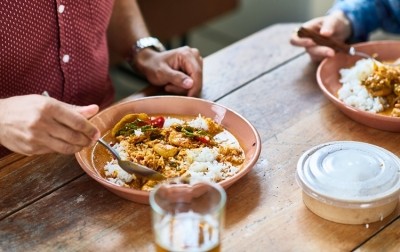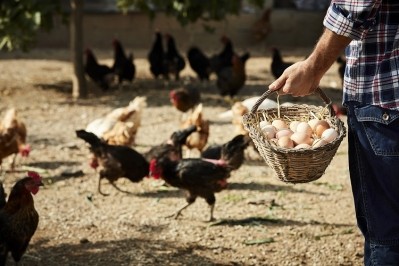It’s been a difficult 12 months for the world of start-ups, with funding skinny on the bottom in some areas. In line with innovation charity Nesta, enterprise capital funding into meals tech start-ups reached a excessive in 2021, however dropped off by greater than half in 2022.
We’re but to see start-up valuations utterly rebound, however inflation is easing and people with a glass-half-full mentality shall be optimistic for the long run. As Martin Davos, associate at meals tech and meals service funding agency McWin Companions mentioned just lately: “One of the best firms are created in occasions of disaster. One of the best entrepreneurs are additionally cast in occasions of disaster.”
Trying again at 2023, it’s clear that difficult financial environments don’t halt innovation. This 12 months, we’ve met a variety of revolutionary meals start-ups, and as we transfer into December, we thought it becoming to spherical up 5 of essentially the most revolutionary.
From a start-up upcycling ‘spent hens’ into flavour enhancers to a different producing breast milk in a lab, listed here are 5 start-ups that caught our eye in 2023.
Vegbloc: Substituting, however not mimicking, meat
First up is Vegbloc, a UK-based start-up that has but to achieve the market. What units Vegbloc aside is just not that it’s making plant-based meat substitutes – we’ve seen that class grow to be more and more saturated – however that it’s approaching meat substitutes by way of a unique lens.
Vegbloc is totally disinterested in meat mimicry: the newcomer doesn’t look, scent, or style like the true factor, and nor does it intend to.
That implies that you received’t discover extruded pea or soy protein isolates on the substances checklist. As a substitute, the meat substitute is created from quinoa, pink lentils, cut up peas, flax seed, onion, chia seed, gram flour, rosemary, candy potato, mushroom, garlic, dietary yeast, smoked paprika, salt, mushroom powder, coriander and black pepper.
As a pleasant apart, its carbon footprint is greater than 30 occasions decrease than that of beef.
“We’re upfront in regards to the substances of Vegbloc and it’s attracting the eye of meat-eaters who’re suspicious of ‘pretend meats’, in addition to scratch cook dinner vegans/vegetarians/reducers who would love a extra handy choice that’s nonetheless pure,” co-founder Simon Day advised FoodNavigator in June. (If Day’s identify sounds acquainted, it’s as a result of he’s additionally the founding father of start-up competition Bread & Jam in London).
In shifting away from meat mimicry, Day foresees potential to attraction to customers throughout the UK and even Europe. The idea is already, in its prototype stage, proving widespread amongst customers. “After you have shed the straitjacket of mimicry, you’ll be able to drop extremely processed and undesirable substances and you might be free to create actually nutritious merchandise with their very own scrumptious style and texture…
“The primary response is that that is one thing genuinely new and that it’s refreshing that we’ve created one thing with its personal texture and flavour that isn’t making an attempt to imitate meat!”
FoodNavigator’s article Vegbloc: Meet the start-up substituting, not imitating, meat with a clear label may be learn in full right here.
ÄIO: Turning sawdust into meals
Estonian start-up ÄIO began life at Tallinn College of Expertise, the place Petri-Jaan Lahtvee and Nemailla Bonturi labored collectively to supply edible fat and oils from agricultural and wooden side-streams.

Now coming as much as its two-year anniversary, ÄIO believes its resolution may help provide options to tropical oils and animal fat for a number of industries, together with meals.
Onerous vegetable fat are at present used for a lot of functions, starting from meals formulation to cosmetics. However palm, coconut, shea and cocoa can solely be grown within the tropics and convey environmental sustainability issues. The options, in line with ÄIO’s founders, is to make use of fermentation processes to ship new fat and oils they declare are wealthy in fatty acids and antioxidants.
ÄIO makes use of a ‘pink bug’ microbe – created and patented by Bonturi – which feeds on facet streams from agriculture, meals and wooden industries, similar to sawdust, lactose and molasses. “In the identical manner that we make kombucha, yogurt, bread, and beer, we are able to flip sawdust or different low-value biomass into precious and wholesome substances,” mentioned Bonturi. “Our ‘pink bug’ can not flip water into wine, however it may flip sawdust into meals.”
Subsequent up, ÄIO desires to extend manufacturing capability, check merchandise in cooperation with meals trade gamers, and apply for novel meals permits to enter the European market. The beginning-up hopes to start out producing its fat and oils at industrial scale by 2026.
This 12 months, the start-up raised €1m from traders together with Nordic Foodtech VC and the Estonian Enterprise Innovation Company.
Our full article Upcycling sawdust to make various oils and fat is accessible to learn right here.
Nūmi: Changing toddler components with cultivated breast milk
Simply final month, we caught up with co-founder of French biotech start-up Nūmi Eden Banon, who along with Eugenie Peze-Heidsieck is seeking to exchange ‘insufficient’ toddler components.
The difficulty is that the overwhelming majority of child components in the marketplace is created from bovine milk, with a small proportion made with from soy and rice. Whether or not created from cow’s milk, grains or legumes, present choices are lower than scratch, defined Banon.
“The complexity of breast milk solutions all of the wants for infants’ improvement, starting from mind and retina improvement to satiety regulators and boosting the immune system. It’s composed of over 1,500 constituents and making an attempt to copy that coming from one other species is suboptimal.”
So as a substitute of sticking with the established order of cow’s milk-based components, Nūmi is popping to cell tradition to breed human milk from mammary cells. Cell tradition know-how includes rising cells beneath managed circumstances, normally exterior of their pure atmosphere. Nūmi is recreating the mammary gland atmosphere (the organ liable for milk synthesis) for human cells to improvement produce milk.
“We use a number of sources of efficient cell traces and domesticate them in managed circumstances,” we have been advised. Particularly, the staff isolates chosen cells, cultivates them in managed circumstances, and feeds them vitamins to develop, duplicate, and produce human milk. The ultimate step is purification, earlier than being prepared for human consumption.
“Cell tradition know-how permits you to replicate the entire phenomenon of lactation in vivo, in vitro utilizing what nature does finest – however now with the assistance of science.”
Nūmi might want to file for pre-market authorisation earlier than getting into the market, and Banon expects it’ll initially launch within the US. “The US…is extra welcoming of improvements on this discipline and have arrange a extra outlined regulatory panorama for improvements like ours, whereas Europe continues to be evolving.
“We very a lot hope that Europe will comply with and that we’ll have the ability to deliver our merchandise to European and French households fairly quickly.”
Our full article Cell-based breast milk in improvement to interchange ‘suboptimal’ bovine toddler components is accessible to learn right here.
Rice in Motion: More healthy, extra sustainability rice

Rice is a staple crop for greater than 3.5bn individuals world wide. Having been cultivated way back to 5000 years BC, rice innovation – exterior of plant breeding and genetic modification to enhance sustainability credentials – is uncommon.
However in Spain, the traditional grain has been revamped by start-up Rice in Motion. Utilizing proprietary know-how, Rice in Motion has lowered rice’s glycaemic index and its cooking time, with advantages for well being, sustainability and productiveness.
The beginning-up claims its rice can provide foodservice purchasers a 12-fold enhance in productiveness, whereas chopping power prices sixty-fold.
With out going an excessive amount of into the patent pending know-how, Rice in Motion chilly infuses rice with broths, flavours and vitamins in a ‘exact manner’. The rice may be booked in simply two to 4 minutes, with out the necessity to add water or broth. “We now have turned a common and scrumptious ingredient – however one that’s usually difficult as a consequence of lack of culinary abilities and hectic existence – into a super velocity scratch cooking ingredient,” Christophe Pais, co-founder of the Madrid-based start-up, advised FoodNavigator earlier this 12 months.
On the identical time, the ‘minimal processing’ utterly adjustments the rice’s dietary properties to incorporate a better proportion of slowly digestible starch (SDS), chopping its glycaemic response. “If conventional cooked rice has 24% SDS our rice has 52%. Which means that it releases sustained power with out inflicting blood glucose spikes. Our GI [glycaemic index] is just 23 when the GI of white rice is 70.
“On high of that, our rice may be infused with vitamins in a exact manner, so we are able to manufacture extremely focused diet meals for particular age teams.”
Our full article This opens up a brand new class’: Meet the start-up making a ‘game-changing’ low GI, quicker-cooking rice is accessible to learn right here.
Diminished: Making flavour enhancers from the ugly facet of poultry manufacturing
One other upcycling start-up that caught our consideration in 2023 was Copenhagen-based Diminished. The corporate has joined forces with substances suppler Caldic to discover and scale upcycled substances for meals makers within the Nordics and Baltic states.

However Diminished is just not working with the extra widespread brewer’s spent grain or yeast. As a substitute, the biotech is seeking to spent hens, which it describes as an ‘untapped useful resource’.
The time period ‘spent hens’ is used to explain chickens on the finish of their egg-laying cycle. With meat that’s too powerful to eat, their business worth is normally low. Usually, they’re processed into ‘chick pulp’ to be used in animal feed or biogas manufacturing. Different occasions they’re discarded. In Denmark alone, 8m kilos of natural chickens are wasted per 12 months.
Diminished is utilizing fermentation methods at industrial scale, combining fungi with rooster and extracting the ‘tremendous umami-rich liquid’ on the finish. The liquid, which can be utilized as a flavour enhancer, is licensed natural and authorised by meals authorities, we have been advised.
Along with Caldic, Diminished can be taking a look at utilizing Danish natural button mushrooms to supply umami flavouring. Industrial producers of Agaricus Bisporus mushrooms, which make up 45% of world mushroom manufacturing, have an 8-10% waste charge on all manufacturing yearly, Diminished co-founder Emil Munck de Voss advised FoodNavigator.
“For our associate in Denmark, that quantities to 203 tonnes of wasted natural Agaricus Bisporus a 12 months. The mushrooms we’re utilizing normally are discarded for retail gross sales as a result of they’re too massive, or too small to be packaged, damaged or bruised. We use them for natural, clear label and great-tasting meals substances and thereby we cut back meals waste.”
The flavour enhancers purpose to spice up umami style in meals formulation with out components. To this point, they’ve been utilized in meat merchandise, meat hybrids and meat options to scale back uncooked materials prices, decrease salt content material and improve flavour.
“Our substances have the potential to decrease prices by enabling the creation of meat hybrids,” mentioned de Voss. “By means of a sequence of formulations, we’ve demonstrated that meat content material in processed meat merchandise may be diminished by 5-20% and substituted with greens and our flavour enhancers.
“This not solely maintains the nice style but additionally lowers the fee by eradicating costly meat content material. We now have demonstrated price financial savings in between 5-10% working with formulations of sausages and beef patties.”
Our full article Embracing ugly veg and the ugly facet of poultry manufacturing to make extra worthwhile and sustainable merchandise is accessible to learn right here.

